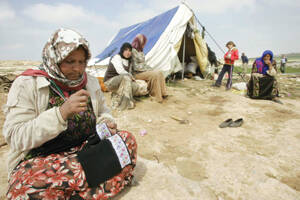Beit Arabiya,” the home of Arabiya and Salim Shawam-reh, a Palestinian couple, was demolished by Israeli authorities on Jan. 23 for the fifth time since 1994. Three houses as well as outhouses and animal pens were knocked over by bulldozers accompanied by heavily armed soldiers as 20 residents, including young children, looked on.
The main house, Beit Arabiya, was dedicated by the Shawamreh family as a peace center after its last demolition and reconstruction and was regularly put to use by the Israeli Committee Against Home Demolitions. This most recent bulldozing of the Shawamreh home is an example of a stepped-up rate of home demolitions by Israeli authorities on the West Bank. Almost 1,100 Palestinians, over half of them children, were displaced by home demolitions in the West Bank by Israeli forces in 2011—over 80 percent more than in the previous year—according to a United Nations report released on Jan. 26.
“Demolitions and Forced Dis-placement in the Occupied West Bank,” prepared by the U.N. Office for the Coordination of Humanitarian Affairs, reports that an additional 4,200 people were affected by the demolition of structures related to their livelihoods. According to the O.C.H.A., in 2011 Israeli forces destroyed 622 Palestinian structures including homes, animal shelters, classrooms and mosques—a 42-percent increase over 2010. At least 93,100 residents remain at risk of displacement.
The home demolitions have been widely condemned. “The current policy and practice of demolitions cause extensive human suffering and should end,” the U.N. humanitarian coordinator for the occupied territories, Maxwell Gaylard, said on Jan. 27. In an annual report on conditions within the Occupied Palestinian Territories, Human Rights Watch reported on Jan. 22 that on the West Bank and East Jerusalem, Israel had by Nov. 1 demolished some 467 Palestinian homes and other buildings, displacing 869 people, the highest number in five years.
“Israel usually carries out demolitions on the grounds that the structures were built without permits, but in practice such permits are almost impossible for Palestinians to obtain in Israeli-controlled areas,” H.R.W. reports.
According to the United Nations, 90 percent of the demolitions and 92 percent of the displacement occurred in already vulnerable farming and herding communities in the territory known as “Area C”—a zone representing over 60 percent of the West Bank, where Israel retains control over security, planning and building. Seventy percent of Area C is off-limits for Palestinian construction, allocated instead for Israeli settlements or the Israeli military; an additional 29 percent is heavily restricted. Most communities visited by O.C.H.A. in Area C reported that families are being displaced because Israeli policies make it difficult for them to meet basic needs. The inability to build was one of the main triggers for this displacement.
The Israeli State Attorney’s Office has promised to respond by August 2012 to all pending appeals by Palestinians against demolition orders. In practice this will lead to more rapid demolition of many Palestinian buildings that have been tied up in court. Among the structures whose demolition was postponed by Israel’s High Court over the past several years were 32 Palestinian schools with demolition or stop-work orders for all or part of the structure. According to the United Nations, 24 remain in danger of being torn down.








